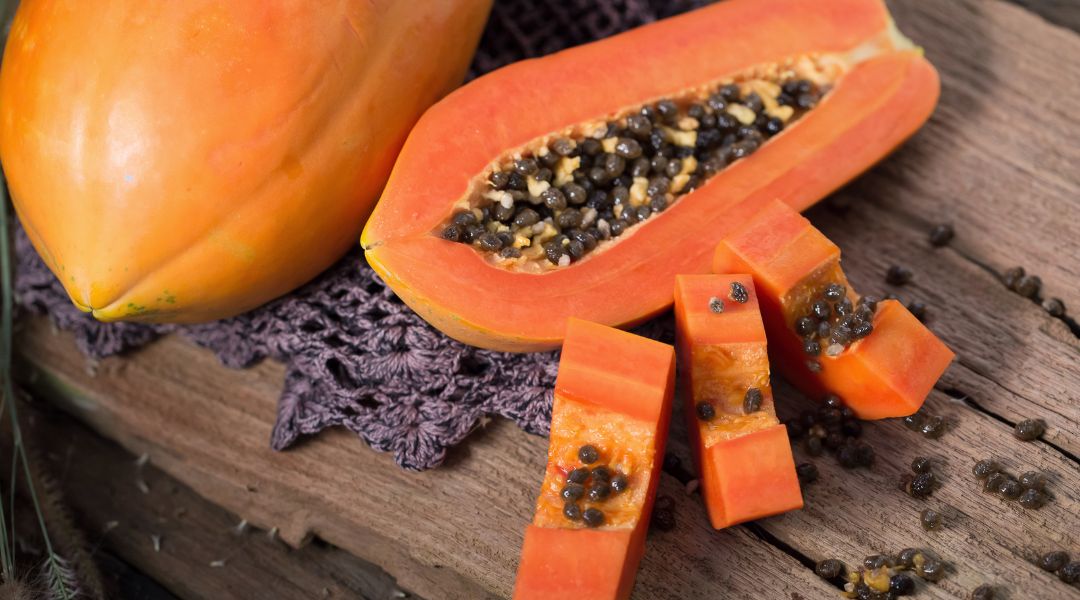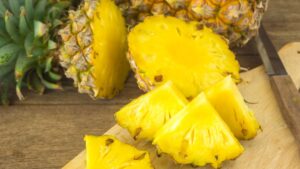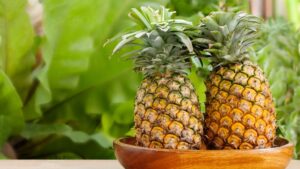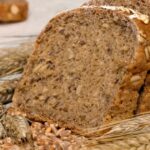Once considered an exotic and rare fruit, papaya (otherwise known as pawpaw) is readily available. It is a fruit that has been long revered for its health benefits. They are soft, fleshy, and extremely versatile.
An unknown internet user summed papaya up perfectly:
The papaya flavor is a combination of mango and nearly banana or peach. People usually think that papaya is a hybrid of the fruit, as mentioned above. Hence it gathers all attraction needed.”
In this blog post, we will discuss some of the health benefits of papaya and how it can help improve your overall well-being. We’ll explore the role papaya plays in improving heart health, digestion, and oh, so many more health conditions.
Physical Description
The papaya is a soft fruit with a colorful appearance and sweet, juicy taste. Its skin is green, smooth, and firm, but the fruit has small, edible black seeds scattered throughout. You can eat papaya in stir-fries, and salads – the only limit is your imagination. The flesh of the fruit is yellow with a slightly-salty flavor and a soft texture.
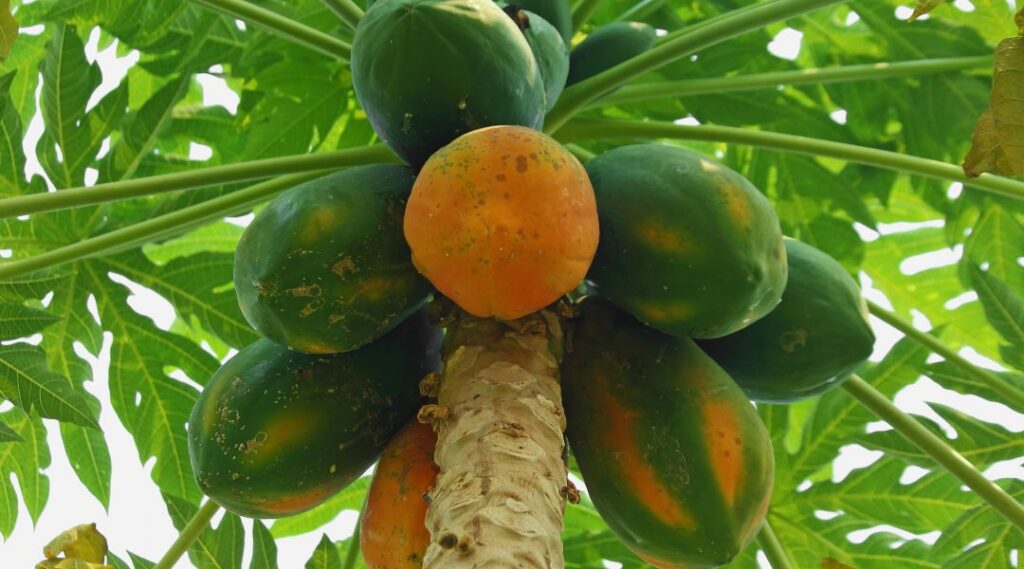
The inside contains small, soft seeds. While you can technically eat papaya seed, it is super easy to scoop out the seed to indulge in the fleshy bits.
In some varieties of fruit, the inside can be white or even pinkish in color. Overall, the physical appearance is festive and appealing to the eye.
Papayas are versatile fruit – add papaya to any meal for several health reasons. You can enjoy papaya fresh or cooked. They are suitable for most climates and seasons as they have a mild but pleasant flavor.
It is worth a mention that it should be handled with care as its delicate skin can cause allergic reactions in some individuals. Likewise, unripe papaya contains an enzyme called papain, which can hurt the esophagus. If you are allergic to papaya, we hope we don’t need to tell you to avoid handling it.
History and Production
Papaya is a fruit native to the subtropical regions of Central and South America. This fruit is known for its juicy, sweet, and citrusy flavor. It is commonly served in salads, smoothies, and desserts.
The history and production of papaya trace its roots back to the pre-Columbian era in Central America when humans began cultivating this fruit. It was already revered for its range of health benefits long before it reached our shores.
Today, papaya farms are common in countries including the United States, Canada, and Mexico.
Several factors contribute to the quality and availability of papaya. First and foremost, papaya is grown under optimal conditions with proper sunlight exposure, temperature, and humidity levels. Finally, effective harvesting techniques must be used to ensure consistent quality throughout the season.
What Is the Ph Scale?
The pH scale measures the concentration of hydrogen ions in a solution. These ions are produced when a substance has a lower pH value. A lower pH value indicates higher concentrations of hydrogen ions in the solution.
Confused? Don’t be. The pH scale ranges from 0 to 14, with 7 as the neutral. Values below 7 represent an increase in hydrogen ions, and values above 7 represent a decrease. Simply put, the pH scale is used to determine the acidity or alkalinity of foods and beverages. For example, the pH level of water can be measured to determine its acidity or base-causing potential.
In addition to water, many foods also contain acids or bases that can affect the pH level of the food. Some examples include tomatoes, which have high acidity and bring the pH level of food down. On the other side, we have baking soda, which has a base-causing potential and increases the pH level.
Papaya has a Ph value of 5.5 – 5.9 which is closer to acidic foods. However, it is still alkaline-forming and safe for alkaline diets. This pH level is far higher on the scale than other tropical fruits which proves the low tartness of the fruit. Other fruits that are also considered high in pH include grapefruit, lemons, limes, mangos, cranberries, and more.
Nutrition Facts About Papaya
One serving of papaya contains about 119 calories, 3 grams of carbohydrates, and 4 grams of fiber. It is a good source of vitamin C (20% DV), folate (200% DV), and magnesium (31% DV). The fruit is also a good source of potassium (5% DV) and vitamin E (5% DV).
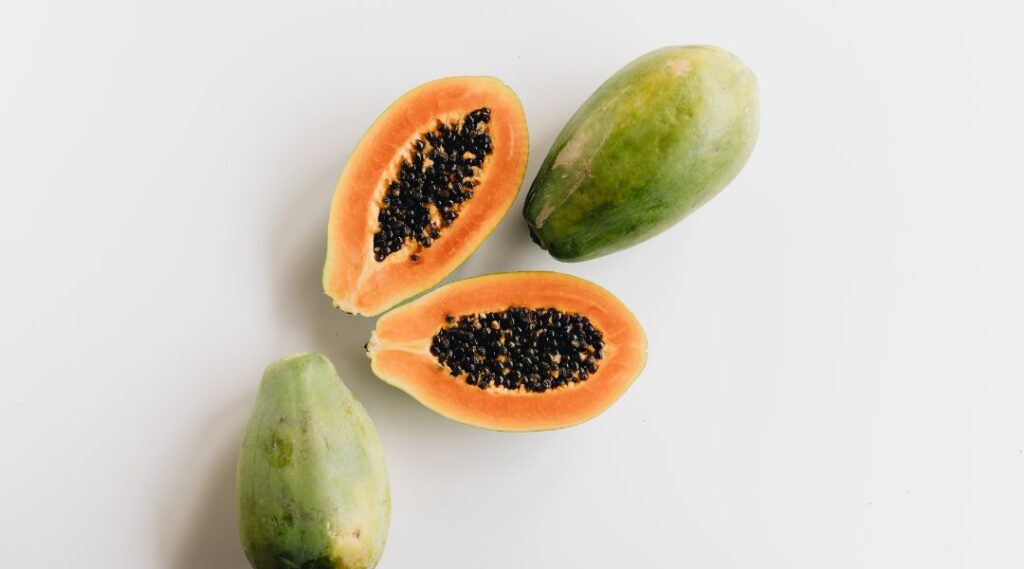
In addition, papaya also contains carotenoids like lutein and zeaxanthin, which can have some benefits to eye health. Overall, papaya provides valuable nutrients and powerful antioxidants in a delicious and easy-to-consume form.
The papaya health benefits are well known, especially in the keto community. These delicious fruits are high in fiber, which can help to reduce inflammation in the body. The added fiber is also sure to kick constipation to the curb,
Papayas can also be a good source of vitamins A and E to fight off free radicals. It is believed, (or actually proven) that free radicals may reduce premature signs of aging.
As an extra sweetener, so to speak, papaya fruit contains low carbohydrates and a moderate amount of protein. This makes them ideal for people following an alkaline diet. In addition to their many health benefits, papayas are sweet and delicious, making them an exciting addition to any diet!
Benefits of Papaya
In addition to its nutritional benefits, papaya may also be beneficial for you if you are following an alkaline diet due to its high levels of alkaline-forming nutrients. These include dietary fiber and vitamins B6 and B12, which help to balance out your body’s pH levels and promote great health.
Overall, papaya is a nutritious fruit that has many health benefits, making it a great addition to an alkaline diet plan. Papaya is high in an antioxidant called lycopene, which alone is renowned in itself for a wide variety of health benefits.
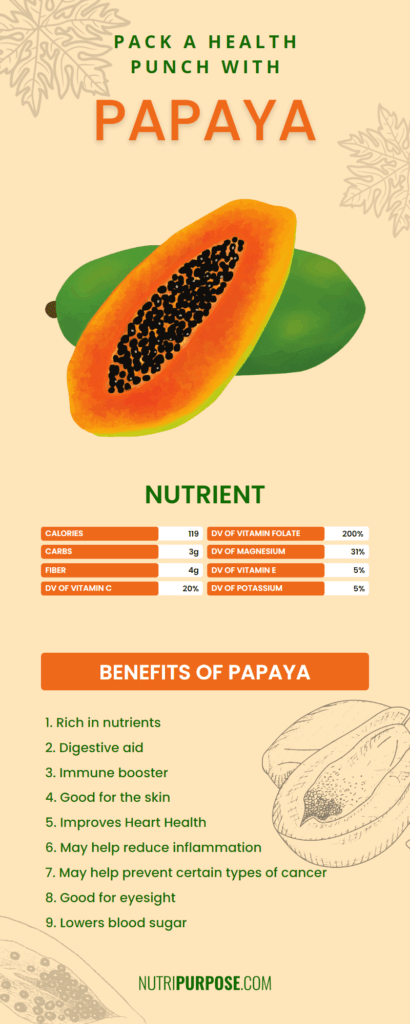
Copy this code and paste to your website
<a href="https://nutripurpose.com/benefits-of-papaya/"><img style="width:100%;" src="https://nutripurpose.com/wp-content/uploads/2023/02/Papaya.png"></a><br>Read More <a href="https://nutripurpose.com/benefits-of-papaya/">Papaya</a>List of Papaya Benefits
These nutrients help to support overall health and promote optimal body function. They include:
- Vitamin C – essential for the production of collagen, a structural protein found in skin and connective tissues
- Iron – important for the formation of red blood cells and oxygen transport in the body
- Manganese – crucial for energy production and metabolism
- Potassium – important for regulating the voltage across cells and maintaining a normal heart rhythm.
- Lycopene – Lycopene is found in papaya and other red or orange fruits. Some health experts believe that lycopene contains anti-cancer properties that reduce the risk of breast and prostate cancer.
- Papain and Chymopapain Enzymes – Both these enzymes digest proteins and help with inflammation as well as digestion.
In summary, an alkaline diet can benefit from including papaya as it provides essential nutrients to support healthy digestion, metabolism, and overall well-being. It is your perfect all-rounder to fight and prevent the risk of heart disease. Why not add some papaya to your diet? One small papaya a day can also help reduce the risk of prostate cancer!
Papaya Recipes
Papayas can be used in everything from smoothies, stir-fries, breakfasts, and much more. Below are just two recipes to introduce into your alkaline diet to start seeing some healthy results in your pH-conscious journey.
Papaya Smoothie Recipe
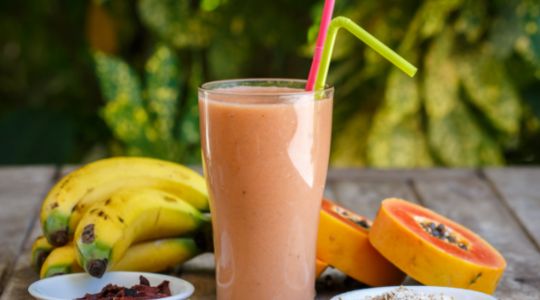
Papaya smoothies have a unique and refreshing flavor. It is high in essential vitamins and minerals, including vitamin C, vitamin A, and fiber. It is also a good source of protein and essential fatty acids. This papaya smoothie recipe requires only a few ingredients and is quick to prepare.
Ingredients:
- 1 ripe papaya
- 1 banana (frozen or fresh)
- ½ cup unsweetened coconut milk
- 1 cup crushed ice (optional)
Instructions:
Salt and black pepper to taste
- Cut the onion into thin slices and thinly slice the garlic cloves. Peel and chop the papaya into small pieces. Slice chicken breast or thigh meat into bite-size cubes. Toss all of the ingredients together in a bowl until well coated with spices.
- Spread cornstarch on one side of a sheet of baking paper. Add chicken and papaya mixture to the pan, stirring constantly until all ingredients are coated in cornstarch.
- Heat olive oil or vegetable oil in a large frying pan over medium-high heat. Add chicken and onion mixture, then cook until both are browned on each side (about 5 minutes).
- Stir in bell pepper and garlic cloves, cooking for about 2 minutes more before adding water to thicken juices if needed (Cornstarch should thicken juices).
- Season with salt and black pepper.
Get Preppy with Papaya!
Are you running to the store to find your new favorite low-acid fruit? With such versatility to incorporate it into everything forms snacks and breakfast to dinners, there is no reason not to have this nutrient-rich fruit in your kitchen.
By incorporating papaya into your alkaline diet you will be able to achieve a higher antioxidant intake, especially lycopene, and enzymes.

I am a professional health and nutrition writer with extensive experience in the industry. My passion for sharing valuable insights on nutrition and wellness stems from over 15 years of personal training and maintaining a healthy lifestyle. My commitment to continuously educate myself on the latest trends and research in the field allows me to deliver high-quality content that is informative and engaging. My mission is to empower individuals to make informed decisions about their health and well-being through my writing.
